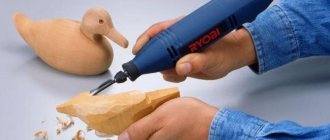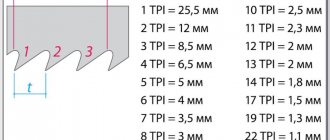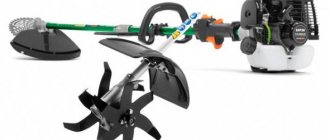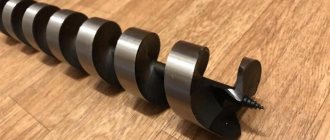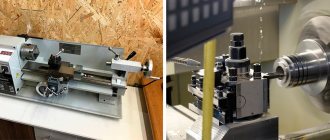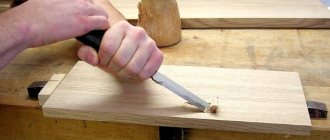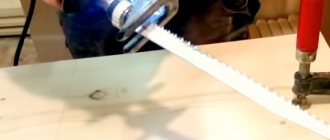Updated: 04/22/2021 16:53:16
Expert: Andrey Nikolaevich Kuznetsov
*Review of the best according to the editors of expertology.ru. About the selection criteria. This material is subjective in nature, does not constitute advertising and does not serve as a purchase guide. Before purchasing, consultation with a specialist is required.
In every woodworking workshop, a tool such as a chisel plays an important role. It is designed for cutting wood, both manually and using machines. The chisel consists of two components, the cutting part and the handle. There is a wide range of this tool on sale, so a novice joiner or carpenter cannot do without expert advice.
How to choose a chisel
- Purpose
. The starting point for choosing a chisel is the purpose of the tool. The home owner should have a flat chisel with a blade width of 14-30 mm in his suitcase. Carpenters and joiners will need models with different cutting edge sizes (from 6 to 32 mm). And for curly cutting of wood you will need a specialized tool with a rounded blade. - Cutting part
. To ensure that the blade remains sharp for a long time, special high-carbon or tool steel is used. During the heat treatment process, the hardness of the blade is brought to the level of 60-65 HRc. The manufacturer does not always bring the sharpness to razor sharpness. Therefore, the craftsman needs to bring the cutting edge to perfect condition immediately after purchase. - Lever.
The requirements for the handle vary significantly among different craftsmen. Some value durability, because in the process of creating a masterpiece they have to hit the back with a hammer. For such craftsmen, an all-metal structure or a handle with a steel impact heel would be suitable. Other woodworkers prefer soft, comfortable handles that won't slip out of the palm. In this case, two-component structures look optimal. - Additional accessories
. A chisel is a fairly vulnerable tool to mechanical stress. Therefore, it must be carefully stored and the blade adjusted in a timely manner. When purchasing several chisels, preference should be given to sets with a case. Many manufacturers carefully equip their blades with protective plastic caps. And some sets are thoughtfully equipped with a sharpening stone. If the master prefers to store the tool on a stand, then there should be a special through hole in the end of the handle.
We have selected 8 of the best chisels for our review. The final positions in the ranking were determined by the opinions of experts and reviews of Russian woodworkers.
Device and characteristics
Structurally, a chisel is a metal sheet with a sharp blade located at the end.
On the reverse side there is a wedge-shaped shank, reminiscent of an ordinary nail, onto which the handle is driven.
In the classic version, the handle is made of wood, and a metal cap is installed at the point where it joins the blade.
Its purpose is to tighten the wood fibers and prevent the tool from breaking under pressure.
There are hand and impact chisels.
In the first case, cutting into the material is performed by hand pressure, and in the second case, by light blows with a mallet on the end of the chisel.
On the handles of impact mallets, in addition to the main cap on the back, there is a metal ring that acts as a headband and prevents cracking of the wood under impact loads.
Material
In the production of chisels, a durable but not brittle alloy is used.
All the requirements are fully met by tool steel grades KhVG, 9ХС and 9ХФ.
It is permissible to use steels with similar mechanical properties.
According to the method of manufacturing the canvas, they are distinguished:
- Stamped chisels.
- Forged - with increased blade thickness for processing materials with increased hardness.
- Punching – provide significant precision in processing products that have lower characteristics in terms of hardness and density.
As for the handles of chisels, in the classic version the material used for production is tough wood, for example, maple, ash, hornbeam, oak.
In addition, impact-resistant plastic or other material with similar characteristics is used.
In modern versions, the handle comes in:
- Two-component - it is based on impact-resistant plastic with rubber inserts for easy holding and to prevent hand slipping.
- Three-component. A combination of impact-resistant plastic at the ends with a softer appearance in the middle and rubber inserts or rubberized coating.
For percussion options, a metal butt plate is installed on the handle.
Dimensions and weight of the chisel
The standard length for chisels is considered to be 125 - 280 mm, where 110 - 145 mm falls on the blade, the width of which ranges from 4 - 50 mm.
Weight is 100 – 400 g.
GOST
Technical requirements and basic dimensions of flat and semicircular chisels are regulated by GOST 1184-80, which, in turn, contains references to GOST 14959-79, GOST 5950-73 and GOST 1435-75 (technical requirements for blade steel grades), as well as to GOST 2695-83 (regarding wood for handles).
Marking
Considering that tool steel is used in production, the marking on the product looks like the inscription “chrome vanadium”, CrV or drop forged.
In this case, a mandatory condition is the presence of a mark about the manufacturer, which is a kind of guarantor of quality.
On high-quality carving chisels, the steel grade is indicated directly on the blade using the electrographic method.
Attention!
Labels like “Hardened steel” should not be trusted.
Foreign manufacturers almost always indicate in the marking the elements present in the alloy, conventionally designated, for example, as W+Cr+V, or Cr+W, simply Cr or W.
The steel grade itself is also often indicated, for example, 86CrMoV7 or 62SiMnCr4.
Rating of the best chisels
| Nomination | place | Name of product | price |
| Best flat chisels | 1 | Hart HCC32 32mm | 1 230 ₽ |
| 2 | DYNAGRIP Stanley 0-16-890 30 mm | 717 ₽ | |
| 3 | MATRIX Tiger eye 24503, 8 mm | 236 ₽ | |
| The best semicircular chisels | 1 | NAREX SUPER 2009 LINE PROFI 16 mm | 1 100 ₽ |
| 2 | FIT 43141 8 mm | 205 ₽ | |
| Best Chisel Sets | 1 | Stanley DYNAGRIP 2-16-885 | 2 359 ₽ |
| 2 | NAREX SUPER 2009 LINE PROFI 8, 10, 16, 32 mm | 2 076 ₽ | |
| 3 | COBALT 245-695 | 1 380 ₽ |
Main selection criteria
Remember 3 important qualities that a chisel must meet:
- durable tool
- resistant sharpening,
- reliable handle.
The durable chisel is made of high-quality steel and a high-quality handle, which are carefully processed and connected to each other.
Durable sharpening and cutting quality depend on the grade of steel from which the blade is made and on proper sharpening.
The steel must be hard and tough, preferably chrome vanadium alloy steel (chrome vanadium or CrV; ХВГ; or С105W2). Carbon steel (labeled U7 or U8) is cheaper, but it is very brittle and breaks quickly. Sometimes such marks are also on fakes, but if you are careful, you will recognize them by their low price and the absence of the manufacturer’s address.
The handle of the chisel should be strong and have a steel cap at the end, which you will hit with a mallet or hammer. These strong impacts often cause the wood of the handle to fall apart. Therefore, it is better to buy a chisel with a handle made of viscous plastic.
Of course, on the modern market there are also electric chisels with interchangeable attachments of different shapes. They are used to remove large masses of wood, speeding up and facilitating the work process.
You shouldn’t shell out money for overly expensive chisels, because very often, purely by accident, you will hit metal objects with them, such as nails, screws, staples, and this will damage the blade. Choose inexpensive but high quality tools. The main thing is not to forget to sharpen them on time and keep them in order. But first of all, learn how to use them correctly, without harming your health and the integrity of the instruments.
Best flat chisels
Flat chisels are used to make straight cuts in wood. With their help, small areas are planed, rectangular or square-shaped recesses are made, grooves and chamfers are selected. The tool differs in the width of the cutting part. Experts recommend the following products for use.
Hart HCC32 32mm
Rating: 4.9
Experts named strength and durability as the main advantages of the Hart 32 mm HCC32 chisel. The American-Chinese instrument has an all-metal construction. The manufacturer chose forged steel as the material. Through selective heat treatment, it was possible to obtain a unique combination of a hard blade and a relatively soft handle. Therefore, the chisel copes well with both cutting and planing, and with gouging out niches. The presence of a striking plate allows you to use not only mallets, but also metal hammers. The tool becomes the winner of our rating.
Users praise the chisel for its versatility, reliability, and sharpness of the cutting part. Only the weight of the product is impressive (610 g).
Advantages
- wide cutting part;
- all-metal construction;
- versatility of use;
- sharp sharpening.
Flaws
- high price;
- heavy weight.
Types of chisels and their prices
The names of chisels almost completely determine their features and the nature of the work for which they are intended.
This is how a chisel for working wood is:
- Manual - cutting into the material occurs from hand pressure on the handle.
- Impact - cutting into the material occurs by applying light blows with a mallet to the end of the handle, which has a metal butt plate.
A classic chisel has a shaft length of 150–170 mm, while a shortened one has a shaft length of 65–85 mm.
The following chisels are distinguished by purpose:
Carpentry
For fine and precise processing of workpieces, for example, a figured chisel, which allows you to carve hard and soft wood.
The latter include spruce, poplar, and linden.
Plotnitskaya
For rough, rough processing of workpieces of various types of wood.
Turning
For manual processing of parts rotating in a lathe, they are more often called turning tools.
According to the shape of the longitudinal section of the blade, the chisel can be:
Straight
The most common option is with a straight blade and blade, like a ruler.
Curved
With a longitudinal bend of the entire blade and blade.
Klukarza
With a sharp bend of the blade in the longitudinal direction, the beginning of which is located almost at the end of the straight blade. Used, for example, when cutting into door locks.
If the blade of the tool is sharpened on the reverse side, the corresponding classifier word is added to the name, for example, reverse cranberry.
By the way, reversible blades allow you to create convex parts of decorative relief.
According to the cross-sectional shape of the canvas, the chisel can be:
Flat
With a straight flat cross profile. It can be both wide and narrow, thick and thin (according to the parameters of the canvas).
The shape of the blade can be either oblique or straight. In the latter case, the cutting edge is perpendicular to the blade. Used for rough processing and creating straight lines.
Oblique
The previous version has a cutting edge that is beveled relative to the perpendicular to the blade.
This angle of attack makes it easier to cut into the wood base, increasing roughing speed.
Corner
The transverse profile is made in the shape of an angle (the letter “V”). The angle itself, as a rule, is between 60 and 90 degrees.
With such a tool you can make contour and relief carvings, and they can also be used to assign the contour of the future workpiece.
Radial
The cross section is made in the shape of a semicircle. Hence another name - semicircular chisel.
It is designed to perform accurate and smooth penetration into the material, which is probably why it is considered the most popular and in demand.
Such models are used for carving along a contour that has unevenness, where there are no sharp or right angles. The cutting part comes in two shapes: flat and sloping, and can also have a different radius of curvature.
Bracket (box-shaped)
The cutting edge is straight, with sides of different heights and different angles between these elements.
Suitable for even, narrow samples of material.
Cerasik
In structure it is close to the semicircular varinate, but has a significantly smaller thickness. This figured tool is used in artistic carving.
The cost of the types of tools described above is not too different from each other.
As a rule, the average price is 300 – 700 rubles per unit, and it depends, first of all, on the quality of the materials and the brand itself.
So there are models costing 1,300 rubles and more.
At the same time, the promotion of the manufacturer’s company affects pricing not in the least.
For comparison, a set of “Tatyanka” chisels for hand carving made of U10A steel (made by milling, 12 elements included) with a beech handle will cost about 10,000 rubles, that is, approximately 800 rubles each. a piece.
At the same time, Japanese ones are produced using a manufacturing technology different from traditional ones (two-layer steel with a hardness of 60 HRc), with a handle made of Japanese red oak.
For a similar set from Hattori (10 pieces) you will have to pay about 12 - 13 thousand rubles, which is already 1200 - 1300 rubles per piece.
However, the latter can be sharpened to razor sharpness.
Sets with more tools, of course, cost more.
In addition to tools for wood processing, there are options for work:
- For metal - an impact version of the tool with a specific sharpening configuration that allows you to process soft metals, for example, aluminum.
- For stone - a percussion tool, used for chipping material. A stone chisel is also suitable for giving the workpiece a fine faceted shape.
- For concrete - actually a chisel, but with a different configuration of the working part, including a semicircle. In most cases, it has a pobedite solder and acts as an attachment for a hammer drill.
Electric chisel
Along with the usual tool, they actively use its electrical modification, which is called an electric chisel, also known as a renovator.
The working element is a special attachment made in the form of already familiar chisels, which is selected depending on the type of work.
This universal machine is also called an electric chisel, multi-cutter or electric scraper.
The electric chisel has high performance and allows you to perform precise fine carvings.
The cost of such models is 5 – 9 thousand rubles.
In turn, it happens:
- Network - powered from a household network.
- Rechargeable – powered by a removable battery.
In addition to standard ones, there are also special chisels:
Surgical
The instrument used in medicine is made of surgical steel.
Vivid examples are the otolaryngological chisel for rhinoplasty and the Vojacek grooved chisel, which is used for trephination of the mastoid process using the hammerless method.
Pasichnaya
A tool for the daily work of a beekeeper.
A multifunctional chisel with a nail puller function and devices for lifting glued frames is called “European”.
Price – about 300 rubles.
For loops
A specially designed tool designed for knocking out rounded corners of seats for door hinges and locks after they have been milled. It is also called a corner chisel, but structurally it is very different from the tool of the same name described above.
The domestic modified version is the chisel of Pavel Soldatov, named, in fact, by the manufacturer.
The cost of the latter is around 3,400 rubles.
Plastic
For repairing car wheels, or more precisely, for cleaning protrusions, removing bumps and burrs from the tire.
An alternative name is a chisel-scraper.
Essentially an exact replica of a flat, straight instrument, but made entirely of plastic.
Price – about 200 rubles.
An option that resembles a multitool in design, however, without additional tools.
In fact, this is a folding chisel, where, when folded, the blade is located between the halves of the handle.
This allows you to safely transport and store the tool, for example in a pocket or bag.
Cost – from 600 rubles.
Mini chisel
A miniature version of a full-size tool, mainly used for fine carving on soft materials.
Beweiler (Beveller)
A flat-cut tool designed to thin leather at folds.
Alternative names are edge cutter or French chisel.
Cost – from 200 rubles.
Chisel-chisel
A percussion type of tool used to gouge out excess parts of material.
Chisel-jamb
Power sculpture knife (jamb knife) designed for relief geometric carving.
Each of the wood processing tools listed above has its own area of application, and therefore to create just one decorative relief you may need up to 10 different types of it, also of different sizes.
Tool hardening
Not every steel can be heat treated at home. But the most common carbon steel, from which many tools are made, including files, can be easily hardened. And since old files are convenient workpieces for making, for example, straight and semicircular chisels, especially semicircular cutters, which are not commercially available, we will take a closer look at heat treatment.
So, carbon steel tools can be hardened at home. Hardening includes two operations. During the first operation, the instrument is heated to a cherry-red glow on a gas burner or in another way. A well-cleaned kitchen gas burner is fine for heating small tools. It is even more convenient to use a stove in a rural house for this purpose. The heated tool is quickly lowered into water, the vessel with which is located as close as possible to the burner, and it is moved sharply to get rid of the steam shell that forms around it, which interferes with the contact of the metal with the water.
The second operation (tempering) consists of softening the steel, hardened to the point of brittleness. Now the cutter is heated slightly, controlling the color of the tarnish. Therefore, the scale formed on the tool during the first operation must be removed by light polishing to a shine on fine sandpaper (at least a sharpening chamfer), trying not to damage the blade. A section at a distance of 1-2 cm from the end of the cutter is heated on a flame. Do not heat the cutting tip itself, which can quickly overheat. The tip should be heated by internal heat coming from the rod. You need to monitor the color of the tarnish on the polished surface, catch the moment when the cutting tip begins to turn from blue to cherry, and sharply lower it into water (preferably with a layer of oil on the surface).
Hardening the chisel.
Then the tool, such as a chisel, is tested on wood and sharpened again. If the cutting edge chips during carving, it is necessary to increase the temperature of the second heating to a straw-colored tarnish. A crumpled tool blade indicates that the hardening regime does not correspond to the type of steel or that the operation was unsuccessful: the temperature of the first heating is not high enough, slowdown when lowered into water, not a sharp cooling due to a layer of steam formed in the grooves and bosoms of the tools, or a tempering temperature that is too high.
In other cases, when the tool is not made of carbon steel, it is better to seek help from a specialist, since at home it will not be possible to obtain a high enough temperature to harden high-quality steels. For a carver who has the opportunity to heat a tool, for example, in a muffle furnace or forge, here are some basic recommendations.
The grade of steel can be approximately determined by the spark on the grinding wheel in a dark place (Fig. 5 inset). Thus, a white beam of sparks with individual stars indicates that the steel is carbon, requires slight heating during hardening (up to a temperature of 780 ° C - cherry-red glow) and tempering when the tarnish color changes from violet (for cutting tools) to straw (for work with a mallet). Heat treatment of such steel can be carried out at home using a gas burner.
If there is a short beam of dark red sparks with almost no stars, the high-speed steel is P18. It requires a high quenching temperature - about 1270°C, which corresponds to a bright white glow. This can only be achieved in a large muffle furnace or in a forge.
The hardening temperature is slightly lower (about 1230°C) for P9 high-speed steel. It hardens with a light yellow glow and produces reddish-orange sparkles with a small number of stars on the grinding wheel. Other alloy steels (chrome produces subtle yellow sparks, tungsten produces well-defined red sparks) are hardened with a light red glow (temperature 820-900°C). Alloy steels are best quenched in oil or in water heated to a temperature of 70°C. Approximately the same temperature is required for annealing steel before processing: alloy steels are heated to 1000°C, high-speed steels to 1200°C.
After heating, they should cool slowly along with the oven. It should be noted that with high and prolonged heating, carbon burns out. Therefore, it is better not to harden a tool with a very thin section, or after hardening, remove the sharp decarburized tip on a whetstone or sharpener while cooling. For the same reason, you should not be afraid to sharpen the tool, especially the first one, until a burr forms along the entire length of the blade. Also, if the first test thread with a hardened and sharpened tool does not give the desired result, sharpening must be repeated.
Making homemade cutters for handmade woodworking
A wood carver is a hand tool that is used for artistic wood carving, so many people want to make it themselves.
The product consists of a metal cutting element and a wooden handle. The main carving is done with the sharp part, thus creating figures or paintings.
To make a knife for artistic carving you will need a minimum set of garage tools.
► Tools and equipment:
- grinder;
- grinder for slicing knives;
- jigsaw;
- circular cutter;
- sandpaper.
Additionally, you will need the material itself, in particular tool steel.
►Materials for production:
- wooden round block - section 25 mm;
- steel strip – thickness 0.6-0.8 mm;
- drills (for thread);
- circles for a circular cutter.
The consumable material also includes a grinding wheel, which will be used to grind the cutter for work. Old wheels will be needed as the main raw material for making sharp knives.
Wood turning tools
A turning cutter is a tool designed for manual processing of a workpiece rotating in a machine. Such tools, unlike handmade wood cutters, have a long handle. It is necessary so that the turner can hold the tool comfortably. The presence of such a handle allows you to control the blade without putting much effort into holding the cutter.
The blade of all types of turning tools is also longer than that of hand tools, since the turner needs to clasp it with his left hand when working.
Most types of wood turning on a lathe require only two types of cutters: reuter and meisel.
Reuter is a tool with a cutting part in the shape of a semicircle, which is used for roughing, initial processing of the workpiece. With the help of a rater, the workpiece is ground to give it the approximate shape of the future product.
Meisel is a cutter designed for finishing a piece of wood to obtain a finished product. The blade of this tool is a plate with a beveled cutting part, similar to a jamb knife.
For making the blades of these cutters yourself, old files are most suitable, and the process itself is no different from that described above.
In the process of gaining experience, the beginning carver will determine for himself the most convenient types of cutters, their shapes and sizes. He will learn to create excellent tools and beautiful wood carvings, and this activity may become a lifelong hobby for him.
Source: drevogid.com
